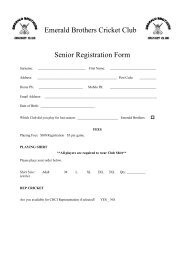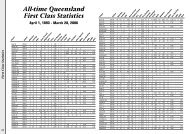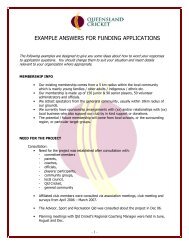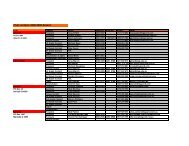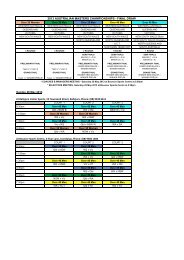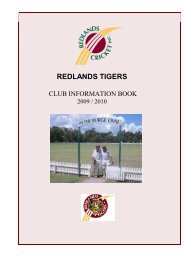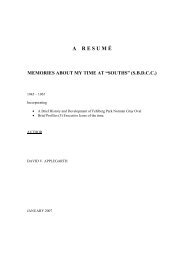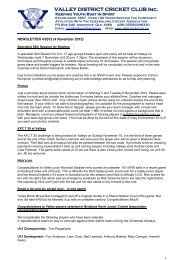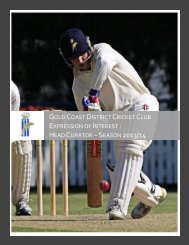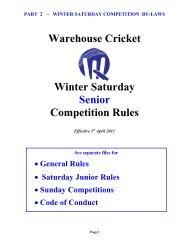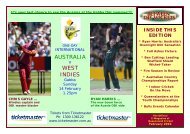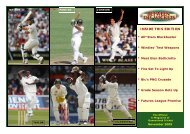the history of western suburbs district cricket club 1921-2002
the history of western suburbs district cricket club 1921-2002
the history of western suburbs district cricket club 1921-2002
You also want an ePaper? Increase the reach of your titles
YUMPU automatically turns print PDFs into web optimized ePapers that Google loves.
-37-on to captain WSDCC but returned to NSW prematurely because <strong>of</strong> family commitments. He was anexcellent slips fieldsman.As stated previously if <strong>the</strong> twelfth man had been chosen on fielding ability alone <strong>the</strong> position would goto <strong>the</strong> youngest <strong>of</strong> <strong>the</strong> three Paulsen bro<strong>the</strong>rs, Steven, better known as Harry. Harry arrived on <strong>the</strong>scene at Wests as a 10 year old, watching his older bro<strong>the</strong>rs Greg (Qld U17 captain in 1994-5, <strong>of</strong> a teamwhich included Hopes and Miller), and Ge<strong>of</strong>f (Qld U19 in 1994-5 in a team which included six subsequentstate players).When finally given his turn in <strong>the</strong> Under 16 Lord Taverners, as a twelve year old, Steven’s leg spinnersimmediately made <strong>the</strong>ir mark by taking 34 wickets at 16.09, in 1994-95, 26 wickets at 16.85 in 1995-96,11 wickets at 14.82 in 1996-97 (toge<strong>the</strong>r with <strong>the</strong> small matter <strong>of</strong> 439 runs at 73.17). The followingseason he took ano<strong>the</strong>r 20 wickets in second and third grades and <strong>the</strong>n moved on to first grade.In season 2001-2 Steven made major advances in all phases <strong>of</strong> his game to <strong>the</strong> extent that he camesecond to Greg Rowell in <strong>the</strong> Peter Burge Medal and was selected to play in a trial match for aQueensland XI against <strong>the</strong> Australian one day team 9-6-02. His advance played a major role in <strong>the</strong>overall success <strong>of</strong> <strong>the</strong> team. He is chosen twelfth man however for his fielding. He is equally adept asa catcher at gully or Silly cover, taking one catch in <strong>the</strong> latter position whilst airborne and parallel to <strong>the</strong>ground in <strong>the</strong> <strong>2002</strong> semifinal which old timers believed was <strong>the</strong> best catch ever at Graceville. Howevereven stronger is his ground fielding at ei<strong>the</strong>r cover or mid wicket where he is building up a significanttally <strong>of</strong> direct hit run outs. His hit rate is probably higher than Ricky Ponting’s.At <strong>the</strong> top <strong>of</strong> <strong>the</strong> order in <strong>the</strong> second team is Jeff Walker, a stylish batsman from Beaudesert who holds<strong>the</strong> first grade single innings highest score <strong>of</strong> 226 not out. Sadly Jeff left <strong>the</strong> <strong>club</strong> in 1985 after fourseasons because he believed he would have a better chance <strong>of</strong> breaking into <strong>the</strong> Queensland team fromAshgrove. He did go on to play two games for Queensland including one against a rampant PatrickPatterson on a Gabba Greentop in 1988-9.Ano<strong>the</strong>r player who also spent two seasons at Ashgrove (including being a member <strong>of</strong> <strong>the</strong> 1996-7 winningfirst grade team) was Andrew Bailey. Andrew first played for Wests as a fourteen year old in 1987-8 andwas again a heavy run scorer in 2001-2. Andrew was fast tracked into first grade in 1991-2 coincidingwith <strong>the</strong> elevation <strong>of</strong> Carl Rackemann to <strong>the</strong> <strong>club</strong> captaincy and did not disappoint, scoring 195 runs at21.66 in two day games as well as a double century opening partnership at Bottomley Park with PaulEveringham when he scored 127 not out in a one day game. A fur<strong>the</strong>r 657 runs at 43.80 next seasonelevated him into <strong>the</strong> state squad for <strong>the</strong> following season, and for a pre season trial match when AllanBorder was injured, <strong>the</strong> best eleven. Andrew top scored in this game. After a couple <strong>of</strong> lean seasonsand <strong>the</strong> two seasons at Ashgrove, Andrew came back to his best in 1999-2000 and 2000-1 scoring morethan 800 runs in all matches in <strong>the</strong> latter season.In many ways Andrew has been a better batsman technically in recent seasons than when he was in <strong>the</strong>state squad in 1993-5. On his day he can thrash <strong>the</strong> best bowlers and is a delight to watch at work. Healso is an aggressive ground fielder and particularly early in his career was an active participant in <strong>the</strong>art <strong>of</strong> “mental disintegration” <strong>of</strong> opposing batsmen.At number three in this team is Jim Hunter who scored 2474 runs at 26.04 in 12 seasons for <strong>the</strong> <strong>club</strong>commencing in first grade in 1975-6. Earlier he had come up through <strong>the</strong> juniors. Jim was an elegantupper order batsman with sweet timing and an excellent slips catcher. He was captain <strong>of</strong> QueenslandthColts and 12 man for Queensland. In 1989-90 Jim dropped down to second grade and scored 530 runsat 88.33. Jim went on to become a Queensland Cricket Coach and Assistant State Coach, playing animportant role in <strong>the</strong> development <strong>of</strong> many <strong>of</strong> <strong>the</strong> players who have won five <strong>of</strong> <strong>the</strong> last eight SheffieldShield/Pura Milk Cup/Pura Cups for Queensland. Toge<strong>the</strong>r with his bro<strong>the</strong>r, Jim developed a <strong>cricket</strong>computer s<strong>of</strong>tware programme that greatly assisted John Buchanan in his stints as Queensland andAustralian coach. Jim left Queensland Cricket in 2000 to market <strong>the</strong> s<strong>of</strong>tware full-time to o<strong>the</strong>r sportsas well as <strong>cricket</strong>.At number four is Ross Lupton, a player who commenced in third grade in 1991-2 as a 16 year old andimmediately made a habit <strong>of</strong> scoring centuries in this grade. His first grade debut was in 1996-7. By<strong>2002</strong> Ross had scored more than 2000 runs for <strong>the</strong> <strong>club</strong> and at times must have been very close tomaking <strong>the</strong> state second eleven. He had performed so well for <strong>the</strong> Glamorgan second XI on his <strong>of</strong>fseason trips to UK that he would undoubtedly have become a first XI player if he had chosen to live in<strong>the</strong> UK and undertaken residential qualification. Despite marrying a Welsh girl, Ross chose to returnpermanently to Australia and was appointed assistant groundsman at Graceville. In 2001-2 <strong>the</strong> harderwickets and consequent higher scores in 2001-2 were a tribute to his diligence.Ross also is a stylish batsman and is capable <strong>of</strong> scoring runs against <strong>the</strong> very best bowlers operatingunder favourable conditions as he did against Kaprowicz and Jackson in 1996-7. Ross can be a veryhandy fast bowler, generating surprising pace at times but in recent years, back injuries have curtailedthis aspect <strong>of</strong> his game.The number five position goes to Peter Cameron who was recruited from Brunswick Heads as an 18year old in 1987-8 by John Bell. Despite a disappointing first season, Peter went on to score 2259 firstgrade runs at 28.28. He became <strong>club</strong> coach in 1997-8 and was at <strong>the</strong> helm during <strong>the</strong> successful 2001-2season. Unselfishly Peter curtailed his own playing career in an attempt to help o<strong>the</strong>rs.Peter’s first grade batting average was higher than o<strong>the</strong>rs who played for <strong>the</strong> state, being pro<strong>of</strong> <strong>of</strong> hisconsistency. Ei<strong>the</strong>r because <strong>of</strong> <strong>the</strong> quality <strong>of</strong> <strong>the</strong> wicket or <strong>the</strong> personalities <strong>of</strong> <strong>the</strong> opposition players,Peter reserved his best for matches at Deagon, scoring two <strong>of</strong> his four centuries and a 90 on this ground.Peter had a sound defence and was an excellent hooker. During his best years it was felt he was veryclose to <strong>the</strong> state second eleven team.At number six in this team is Brett Stephensen who scored 2750 runs at 25.94 and took 170 wickets at30.3 between 1985-6 and 1997-8. Brett came from Beaudesert at <strong>the</strong> start <strong>of</strong> <strong>the</strong> John Bell era and wasone <strong>of</strong> <strong>the</strong> longest survivors from that season. His career highlight was in playing a match for



